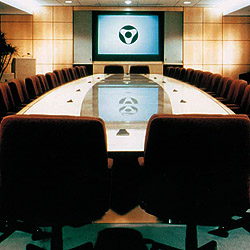
Obviously, this introduces the possibility of interference effects unless certain basic principles, such as the “3-to-1 rule”are followed.
For one microphone, picking up a typical audience, the suggested placement is a few feet in front of, and a few feet above, the heads of the first row. It should be centered in front of the audience and aimed at the last row.
In this configuration, a cardioid microphone can cover up to 20-30 talkers, arranged in a rectangular or wedge-shaped section.
For larger audiences, it may be necessary to use more than one microphone. Since the pickup angle of a microphone is a function of its directionality (approximately 130 degrees for a cardioid), broader coverage requires more distant placement.
As audience size increases, it will eventually violate the cardinal rule: place the microphone as close as practical to the sound source.
In order to determine the placement of multiple microphones for audience pickup, remember the following rules:
1) The microphone-to-microphone distance should be at least three times the source-to-microphone distance (3-to-1 rule).
2) Avoid picking up the same sound source with more than one microphone.
3) Use the minimum number of microphones necessary.
For multiple microphones, the objective is to divide the audience into sections that can each be covered by a single microphone. If the audience has any existing physical divisions (aisles or boxes), use these to define basic sections.
If the audience is a single large entity, and it becomes necessary to choose sections based solely on the coverage of the individual microphones, use the following spacing: one microphone for each lateral section of approximately 8 to 10 feet.
If the audience is unusually deep (more than 6 or 8 rows), it may be divided into two vertical sections of several rows each, with aiming angles adjusted accordingly. In any case, it’s better to use too few microphones than too many.
Once hanging microphones are positioned, and the cables have been allowed to stretch out, they should be secured to prevent turning or other movement by air currents or temperature changes. Fine thread or fishing line will accomplish this with minimum visual impact. Use only high quality cables and connectors, particularly if miniature types are specified.
Many older meeting facilities are very reverberant spaces, which provide natural, acoustic reinforcement for the audience, though sometimes at the expense of speech intelligibility. In spaces like this, it is often very difficult to install a successful sound system as the acoustics of the space work against the system.
Most well-designed modern architecture has been engineered for a less reverberant space, both for greater speech intelligibility, and to accommodate modern forms of multimedia presentations. This results in a greater reliance on electronic reinforcement.
The use of audience microphones is normally exclusively for recording, broadcast, and other isolated destinations. It is almost never intended to be mixed into the sound system for local reinforcement.
If it is desired to loudly reinforce an individual member of the audience, it can only be done successfully with an individual microphone placed amid the meeting participants: a stand-mounted type that the member can approach or a handheld type (wired or wireless) that can be passed to the member.
Good technique for use of audience microphones includes:
—Do place the microphones properly.
—Do use minimum the number of microphones.
—Do turn down unused microphones.
—Don’t attempt to “over-amplify” the audience.
—Do speak in a strong and natural voice

